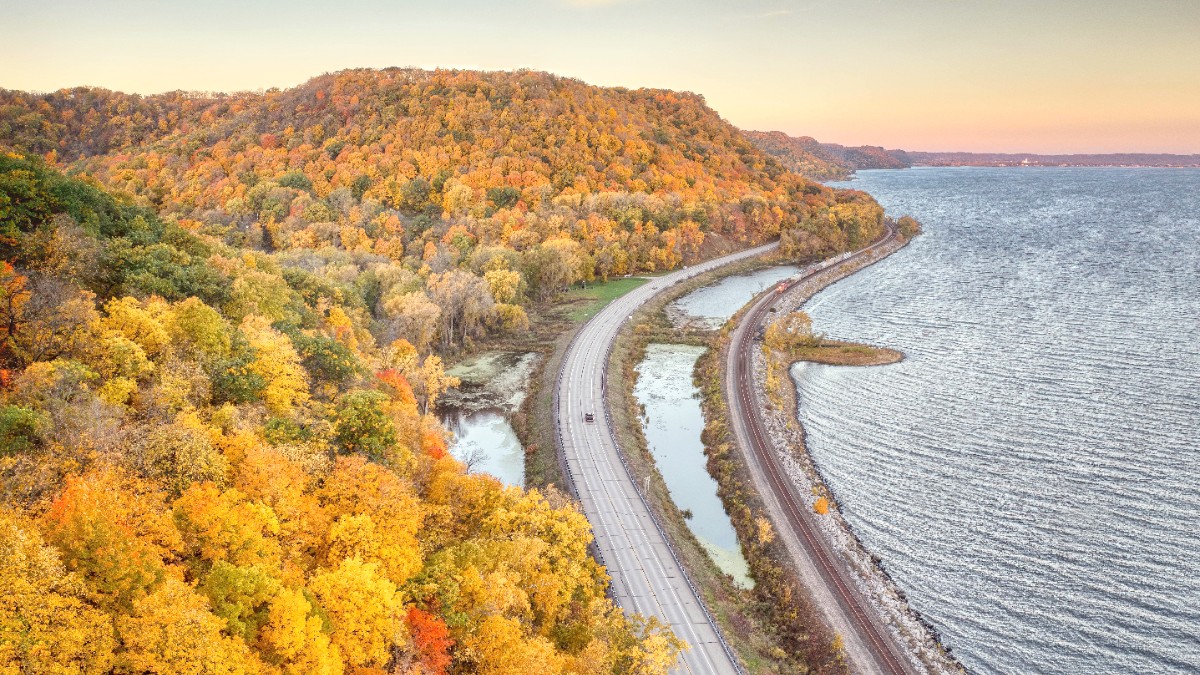
Great Lakes, USA
The city's landscape has numerous lakes, a defining feature that gives Minneapolis its nickname. These are bodies of water, central to the city's identity and its residents' daily lives. The main components of the city’s renowned Chain of Lakes include Bde Maka Ska (formerly Lake Calhoun), Lake Harriet, Lake of the Isles, and Lake Nokomis. These lakes form a continuous parkway, connected by scenic trails for walking, running, and bicycling. The Chain of Lakes has beaches, boat rentals, and picturesque spots for relaxation or activity, even within the city limits. This natural amenity is a major factor in the city's high quality of life and its outdoor recreation reputation.
Beyond the lakes, Minneapolis finds its precise location at the confluence of the Minnesota and Mississippi Rivers. This strategic spot, historically important for trade and settlement, includes natural landmarks. Saint Anthony Falls, the Mississippi River's only major waterfall, once powered the city's industrial boom and a prominent visual and historical feature today.
The falls, alongside the river gorge, make a dramatic natural backdrop for the city's downtown. This riverfront area, with its historic Stone Arch Bridge, has exceptional views and represents the deep connection Minneapolis maintains with its aquatic environment. The careful integration of these natural elements into urban planning gives Minneapolis a visually appealing and highly livable city. The geographic relationship between Minneapolis and Saint Paul means they function as a single metropolitan area, sharing infrastructure, cultural institutions, and an unified public transportation system.
Minneapolis's story begins long before European settlement. The region was originally inhabited by the Dakota people, who lived here for centuries, revering the sacred lands around the Mississippi and Minnesota Rivers. The modern history of Minneapolis began in the early 19th century with Fort Snelling. Built in the 1820s at the confluence of the Minnesota and Mississippi Rivers, this military outpost was a frontier defense and trading post. Its presence brought American settlers, and soon, the immense power of Saint Anthony Falls attracted entrepreneurs.
This natural advantage drove the city's rapid growth. In the late 19th and early 20th centuries, Minneapolis transformed into a global leader in flour milling. Giant mills, like the Washburn A Mill, used the falls' energy to process vast quantities of wheat. This industry brought Minneapolis the enduring nickname "Mill City" and drove its economic prosperity. Simultaneously, the city developed as a major lumber producer. After industrialization, Minneapolis skillfully adapted its economy. Large corporations based their headquarters here, diversifying the city's economic base into healthcare, technology, retail, and food processing. This adaptability meant Minneapolis thrived even as its original industries declined.
The city was a crucible for civil rights and labor movements, reflecting a progressive spirit.
Citizens have a long tradition of philanthropy, giving to numerous parks, museums, and cultural institutions.
Commitment to social progress and community betterment is a defining aspect of Minneapolis's history.
A progressive spirit continues to shape city policies.
Minneapolis is the most populous city in Minnesota, a dynamic center for business, arts, education, and outdoor recreation. It is a city that ranks high in livability, health, and sustainability. Visitors quickly discover a sophisticated urban environment, deeply connected to its natural surroundings.
The city has a diverse and resilient economy, with strengths in finance, healthcare, technology, and food processing. Major corporations are present here, aiding a robust job market and a culture of innovation. This economic vitality drives the city's amenities, from its varied dining scene to its world-class cultural institutions. Minneapolis is renowned for its extensive park system, which earns top national rankings.
The cultural landscape of Minneapolis is impressive. The city houses internationally recognized institutions like the Guthrie Theater and the Minneapolis Institute of Arts (MIA). The Walker Art Center is a leading contemporary art museum. The city also has a legendary music history, a birthplace of Prince's sound. A strong emphasis on bicycling and environmental sustainability defines Minneapolis. The city has an extensive network of bike lanes and trails, and cycling is a popular and practical mode of transportation. Initiatives promoting renewable energy, waste reduction, and green building practices show Minneapolis's commitment to a sustainable future.
Minneapolitans have a friendly, polite demeanor, often called "Minnesota Nice." This welcoming attitude, combined with the city's progressive outlook and high quality of life, gives an inviting atmosphere for visitors. A trip to Minneapolis is a chance to experience a city that truly balances urban sophistication with a deep appreciation for its natural environment and a strong sense of community.
The Minneapolis Park and Recreation Board manages over 180 parks, over 6,800 acres. This includes the iconic Chain of Lakes, Minnehaha Park with its impressive waterfall, and the expansive Theodore Wirth Park. These green spaces have year-round opportunities for recreation. The Grand Rounds Scenic Byway, a 50-mile loop connecting many of these parks, shows the city's commitment to outdoor access.
Minneapolis Institute of Arts (MIA) has a vast collection spanning global art history, and the Walker Art Center is a leading contemporary art museum, complemented by its iconic Minneapolis Sculpture Garden. Venues like First Avenue hold iconic status in music history.
Over 180 parks, including the Chain of Lakes and Minnehaha Park.
Guthrie Theater, MIA, Walker Art Center, and music venues.
Extensive bike lanes and trails for active living.
These green spaces have year-round opportunities for recreation, from summer biking and paddleboarding to winter cross-country skiing and ice skating.